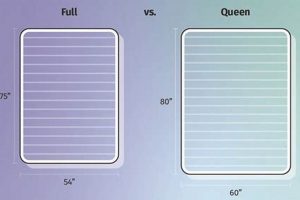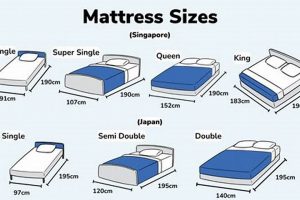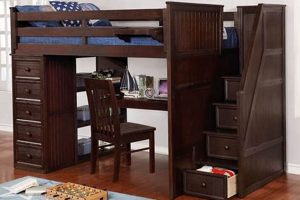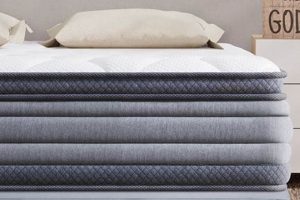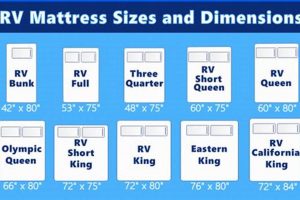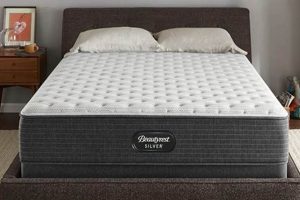A sleeping surface designed to accommodate a young child transitioning from a crib to a larger bed, sized to fit a standard full-size bed frame, and offering features that prioritize safety and comfort is a significant purchase. This type of mattress typically balances support and cushioning to ensure proper spinal alignment and a restful sleep environment for developing bodies. For example, a mattress constructed with CertiPUR-US certified foam and a breathable cover would fall into this category.
Providing a full-size mattress offers several advantages. The larger dimensions allow for more room to move and grow, potentially extending the lifespan of the sleep solution as the child gets older. Furthermore, it can facilitate easier parental interaction, such as reading bedtime stories or comforting a child during the night. Historically, parents often opted for smaller mattresses initially, but the long-term cost-effectiveness and flexibility of a larger size are increasingly recognized.
The selection of an appropriate mattress involves considering several key elements, including material composition, firmness level, safety certifications, and overall construction. These factors play a vital role in determining the suitability and long-term value of the purchase. Therefore, a detailed examination of these aspects is necessary for making an informed decision.
Guidance on Selecting a Full-Size Mattress for Young Children
The selection of an appropriate mattress necessitates careful consideration of several factors to ensure both safety and optimal sleep quality. The following guidelines provide a framework for making an informed purchasing decision.
Tip 1: Prioritize Safety Certifications: Verify that the mattress carries certifications such as CertiPUR-US, OEKO-TEX, or Greenguard Gold. These certifications indicate that the materials used have been tested for harmful chemicals and volatile organic compounds (VOCs), reducing potential health risks.
Tip 2: Consider Firmness Level: A medium-firm mattress is generally recommended for young children. This firmness level provides adequate support for proper spinal alignment while still offering a degree of comfort. Avoid mattresses that are too soft, as they can lead to postural issues.
Tip 3: Evaluate Material Composition: Opt for mattresses made from materials known for their durability and breathability, such as high-density foam or innerspring coils with a comfort layer made of natural latex or organic cotton. Breathable materials help regulate temperature and reduce the risk of overheating.
Tip 4: Assess Edge Support: Strong edge support is crucial to prevent sagging and enhance overall stability, particularly as children tend to move around during sleep. Reinforced edges also provide a safer sleeping surface, minimizing the risk of rolling off the mattress.
Tip 5: Inquire About Waterproof or Water-Resistant Features: Given the potential for accidents, a waterproof or water-resistant mattress cover is highly recommended. This feature protects the mattress core from spills and stains, prolonging its lifespan and maintaining hygiene.
Tip 6: Check for Hypoallergenic Properties: Select a mattress with hypoallergenic properties to minimize the risk of allergic reactions. Materials like natural latex and tightly woven covers can help prevent the accumulation of dust mites and other allergens.
Tip 7: Consider the Mattress Height: Lower profile mattresses may be better suited for toddlers transitioning out of a crib. Shorter height can help the child independently climb on and off the bed with better safety.
Adhering to these guidelines will assist in selecting a mattress that provides a safe, comfortable, and supportive sleep environment. Such choices contribute to the child’s overall health and well-being.
Following these recommendations will enable a well-informed decision, leading to a mattress choice that fosters healthy sleep habits and supports the child’s developmental needs. The following sections will delve into specific product types and features to further refine the selection process.
1. Firmness
Firmness, a crucial characteristic of a sleeping surface, directly impacts spinal alignment and overall comfort, especially for a growing child. For a full-size mattress intended for a toddler, the degree of firmness must provide adequate support to prevent the spine from sinking into the mattress, which could lead to postural problems or discomfort. A mattress that is too soft can cause the spine to curve unnaturally, while a mattress that is excessively firm may not provide sufficient cushioning for pressure points, leading to restless sleep. The goal is to find a balance where the spine is supported in its natural alignment, allowing for proper muscle relaxation and restorative sleep.
The significance of appropriate firmness extends to the long-term musculoskeletal health of the child. Real-world examples illustrate the impact of mattress firmness on sleep quality and physical well-being. A toddler sleeping on an overly soft mattress may experience back pain or stiffness upon waking, potentially affecting their posture and development over time. Conversely, a mattress that is too firm may cause discomfort and prevent the child from achieving a deep, restful sleep, hindering their ability to concentrate and learn during the day. The practicality of understanding firmness lies in its direct correlation with a child’s sleep quality and overall physical development.
In conclusion, the ideal firmness is medium-firm. Selecting a full-size mattress, therefore, hinges on a well-informed consideration of this factor. Balancing support and comfort provides a stable and pressure-relieving surface that promotes healthy spine alignment and restful sleep. The challenge lies in determining the optimal firmness level, which may vary slightly depending on the child’s weight and preferred sleeping position, thereby further underscoring the need for comprehensive product information and, where possible, in-person testing. This understanding, paired with other crucial attributes, contributes to a mattress choice that fosters healthy sleep and supports the child’s developmental needs.
2. Material Safety
Material safety represents a foundational element in determining the suitability of a full-size mattress for a toddler. The proximity of a child to the mattress during extended periods of sleep necessitates the absence of harmful substances that could negatively impact health. The composition of the mattress, including foam, fabrics, and adhesives, must be scrutinized to ensure compliance with stringent safety standards. The potential for off-gassing of volatile organic compounds (VOCs) is a primary concern, as these chemicals can contribute to respiratory irritation, allergies, and other adverse health effects. The selection of a mattress lacking appropriate certifications directly elevates the risk of exposure to these harmful substances, thereby compromising the child’s well-being. Therefore, material safety is not merely a desirable feature but a critical requirement.
Certifications such as CertiPUR-US and OEKO-TEX serve as valuable indicators of a mattress’s adherence to safety standards. These certifications signify that the materials have undergone independent testing to verify the absence of prohibited chemicals and the minimization of VOC emissions. For example, a mattress bearing the CertiPUR-US seal guarantees that the foam components are free from formaldehyde, heavy metals, and certain flame retardants. Likewise, OEKO-TEX certification ensures that the textiles used in the mattress meet stringent human-ecological requirements. The presence of these certifications provides a level of assurance that the mattress is safe for a toddler’s sensitive system, minimizing the risk of allergic reactions and respiratory problems. Real-life examples demonstrate the adverse effects of selecting mattresses without such assurances, with reports of children experiencing skin rashes, breathing difficulties, and sleep disturbances due to exposure to harmful chemicals. Parents must actively seek out mattresses that have undergone rigorous testing and are certified by reputable organizations.
In conclusion, the connection between material safety and the selection of a full-size mattress for a toddler is both direct and consequential. Prioritizing mattresses with recognized safety certifications ensures the selection of products free from harmful chemicals, safeguarding the child’s health and promoting a safe sleep environment. The commitment to material safety is an investment in the child’s well-being, influencing their long-term health outcomes. Choosing a mattress with low VOCs, and without harmful chemical flame retardants offers a safer and more restful experience for the child.
3. Edge Support
Edge support, concerning the structure along the perimeter of the mattress, significantly impacts the overall usability and safety of a full-size mattress intended for toddler use. Insufficient edge support leads to mattress sagging near the edges, creating an unstable sleep surface. This instability increases the risk of a child rolling off the mattress during sleep. Given toddlers’ tendency to move during sleep, robust edge support becomes a vital safety feature. Without it, the functional sleeping area diminishes, leading to potential falls and interrupted sleep patterns. Therefore, considering edge support is essential in evaluating a toddler’s mattress suitability.
The practical significance of adequate edge support extends beyond fall prevention. Strong edges enable a child to sit comfortably and securely on the side of the mattress, promoting independent dressing and bedtime routines. Furthermore, enhanced edge support increases the mattress’s structural integrity, extending its lifespan by preventing premature sagging and distortion. Some mattresses utilize reinforced coils or high-density foam along the perimeter to achieve this support. In contrast, mattresses with weak edges exhibit noticeable compression when weight is applied, signaling a deficiency in structural design. The lack of edge support undermines both safety and long-term value.
In conclusion, edge support is a non-negotiable attribute in evaluating a full-size mattress for toddler use. The presence of robust edge support directly correlates with enhanced safety, increased usability, and extended mattress lifespan. While other factors, such as firmness and material composition, are essential, neglecting edge support undermines the overall effectiveness of the mattress in providing a safe and comfortable sleep environment for a young child. Evaluating this attribute helps ensure a product that supports the child’s physical well-being and fosters independent routines.
4. Water Resistance
The correlation between water resistance and a mattress designed for toddler use is significant due to the increased likelihood of accidents involving bodily fluids and spills. A non-water-resistant surface readily absorbs liquids, creating a breeding ground for bacteria and mold, leading to unpleasant odors and potential health hazards. The capacity to repel liquids safeguards the inner mattress components, prolonging its lifespan and maintaining a hygienic sleep environment. Therefore, water resistance emerges as a critical factor when evaluating a toddler’s sleeping surface.
Practical applications of water-resistant mattress features include the ease of cleaning and maintenance following accidents. A mattress with a waterproof or water-resistant cover allows for quick and efficient removal of spills, preventing them from penetrating the core. For instance, a mattress incorporating a polyurethane laminate or a tightly woven fabric treated with a water-repellent finish demonstrates this functionality. Real-world examples highlight the repercussions of neglecting this feature. A mattress without water resistance can quickly become stained, harbor bacteria, and necessitate premature replacement. The understanding of water resistance translates directly into reduced cleaning efforts, prolonged product usability, and a healthier sleep environment for the toddler.
In summary, water resistance contributes directly to the hygiene, durability, and overall suitability of a full-size mattress for toddler use. The absence of this feature presents a clear risk to the mattress’s integrity and the child’s health. While other considerations, such as firmness and material safety, remain crucial, the inclusion of water resistance ensures that the mattress can withstand the challenges associated with early childhood, offering a practical and hygienic sleep solution.
5. Hypoallergenic
The selection of a sleeping surface for a young child necessitates a stringent focus on materials that minimize the risk of allergic reactions. The term “hypoallergenic,” when applied to a full-size mattress intended for toddler use, denotes a design and construction approach aimed at reducing exposure to common allergens. This is of particular importance given the extended duration a child spends in contact with the mattress and their increased susceptibility to environmental irritants.
- Dust Mite Resistance
Mattresses with tightly woven covers or those incorporating materials like natural latex inherently resist dust mite penetration. Dust mites, microscopic organisms that thrive in bedding, are a primary trigger for allergies and asthma in children. A mattress that effectively inhibits dust mite colonization minimizes exposure to these allergens, creating a healthier sleep environment. An example is a mattress encasement made of tightly woven microfiber that prevents dust mites from entering or escaping the mattress.
- Latex Composition
Natural latex, derived from rubber trees, possesses inherent hypoallergenic properties. Its dense structure inhibits the growth of mold and mildew, common allergens in humid environments. Furthermore, natural latex is typically processed without the use of harsh chemicals, reducing the risk of skin irritation. However, it is crucial to distinguish between natural and synthetic latex, as the latter may contain allergenic additives. Families with known latex allergies should exercise caution.
- Material Certifications
Certifications such as OEKO-TEX Standard 100 indicate that the mattress components have been tested for harmful substances, including allergens and irritants. These certifications provide assurance that the materials used in the mattress are safe for sensitive individuals. For instance, a mattress certified under this standard will have been tested for formaldehyde, heavy metals, and allergenic dyes.
- Synthetic Fiber Selection
In cases where natural materials are not feasible or desired, synthetic fibers such as hypoallergenic polyester can serve as an alternative. These fibers are engineered to resist allergen accumulation and are often treated to enhance their antimicrobial properties. Careful consideration should be given to the manufacturing processes and chemical treatments applied to these fibers to ensure they do not introduce new allergens.
The integration of hypoallergenic features into a full-size mattress for a toddler contributes significantly to a reduced risk of allergic reactions, promoting a healthier and more restful sleep experience. While no mattress can eliminate all potential allergens, prioritizing hypoallergenic materials and construction techniques serves as a proactive step in mitigating exposure to common triggers, ultimately benefiting the child’s overall health and well-being. The thoughtful selection of a hypoallergenic mattress is a crucial component in creating a sleep environment conducive to optimal health.
6. Size
The dimensions of a mattress, specifically the size designation, directly influence its suitability for a toddler transitioning from a crib or smaller bed. A full-size mattress offers increased surface area compared to a twin, providing greater freedom of movement during sleep and accommodating growth. The provision of ample space contributes to improved sleep quality and reduces the likelihood of the child rolling off the mattress. The physical dimensions, therefore, become a determining factor in ensuring a safe and comfortable sleep environment, establishing a causal relationship between size and the overall utility of the mattress.
The full-size format offers a long-term advantage. As the child grows, the larger mattress continues to provide sufficient space, negating the need for premature replacement. This cost-effectiveness is a practical consideration for parents. Furthermore, the expanded area facilitates parental interaction, such as reading bedtime stories or comforting a child during the night. However, careful consideration must be given to room dimensions to ensure that the full-size mattress fits comfortably without overcrowding the space, as an overcrowded room can impede movement and create a less desirable sleep environment. A compact room could possibly diminish the benefit of a full-size, whereas a larger space facilitates optimal use.
In summary, size plays a fundamental role in defining the practicality and effectiveness of a toddler’s mattress. While other factors such as firmness and material composition are crucial, the dimensions provide the foundation for both comfort and safety. The selection of a full-size mattress represents a long-term investment in the child’s sleep quality and overall well-being. However, optimal use of the full-size dimension necessitates planning out the bedroom space, to ascertain it will fit well without overcrowding the room. Therefore, assessing room size alongside mattress dimensions becomes crucial for a well-informed choice.
7. Breathability
Breathability, concerning mattress construction, directly influences temperature regulation and moisture dissipation, critical factors for a toddler’s sleep environment. The effectiveness of a mattress in facilitating air circulation dictates the extent to which body heat and moisture are dissipated, thereby minimizing overheating and promoting a comfortable sleep climate. The subsequent points offer a comprehensive perspective on this aspect.
- Material Selection and Airflow
The choice of mattress materials significantly affects airflow. Open-cell foam structures, natural latex, and innerspring systems promote better ventilation compared to closed-cell memory foam, which tends to trap heat. Mattresses incorporating breathable fabrics like organic cotton or bamboo further enhance air circulation, facilitating moisture evaporation. An example includes an innerspring mattress with a natural latex comfort layer, offering a combination of support and breathability. This construction minimizes heat retention, maintaining a more consistent sleep temperature. The implications of these material choices directly influence the toddler’s comfort and overall sleep quality.
- Construction Techniques and Ventilation Channels
Mattress construction techniques, such as the inclusion of ventilation channels or perforated foam layers, enhance breathability by facilitating airflow throughout the mattress core. These features create pathways for heat and moisture to escape, preventing the accumulation of humidity and maintaining a cooler surface temperature. For example, some mattresses incorporate vertical or horizontal channels within the foam layers to promote air circulation. These design elements augment the mattress’s capacity to regulate temperature and contribute to a more comfortable sleep environment. The practical effect of such construction is reduced tossing and turning caused by overheating during the night.
- Cover Fabric and Moisture Wicking
The properties of the mattress cover fabric significantly impact its ability to wick away moisture. Fabrics with moisture-wicking capabilities draw sweat away from the body, promoting evaporation and maintaining a dry sleep surface. Materials like Tencel or specialized performance fabrics are designed for this purpose. Conversely, synthetic fabrics with poor moisture-wicking properties can trap sweat, creating a damp and uncomfortable sleep environment. A mattress cover made of breathable, moisture-wicking fabric contributes to improved temperature regulation and reduces the risk of skin irritation caused by excessive sweating.
- Impact on Sleep Quality
The breathability of a mattress profoundly impacts the quality of sleep, especially for toddlers, who are more susceptible to temperature fluctuations. A mattress that effectively regulates temperature prevents overheating and minimizes restlessness, promoting deeper and more restorative sleep. Conversely, a mattress that retains heat can lead to discomfort, frequent awakenings, and disrupted sleep patterns. A breathable mattress contributes to a more consistent sleep temperature throughout the night, fostering optimal sleep quality. The cumulative effect of these attributes influences the child’s overall health and well-being.
The breathability attribute directly influences the microclimate within the sleep environment. Choosing mattress components for a toddler involves recognizing breathability’s essential role in ensuring comfort and promoting healthy sleep habits. The impact that breathability plays is crucial to a better, safer night of sleep. This thoughtful attention directly contributes to selecting a mattress that supports optimal health.
Frequently Asked Questions
The following questions address common inquiries regarding full-size mattresses intended for use by toddlers. The responses provide factual information to assist in informed decision-making.
Question 1: What firmness level is most appropriate for a toddler’s full-size mattress?
A medium-firm mattress is generally recommended. This firmness level offers a balance of support and comfort, promoting proper spinal alignment while providing sufficient cushioning for pressure points.
Question 2: What safety certifications should one look for when purchasing a full-size mattress for a toddler?
Certifications such as CertiPUR-US, OEKO-TEX Standard 100, and Greenguard Gold indicate that the mattress has been tested for harmful chemicals and VOC emissions, promoting a safer sleep environment.
Question 3: Is water resistance a necessary feature in a toddler’s full-size mattress?
Water resistance is highly recommended. This feature protects the mattress core from spills and accidents, preventing the growth of bacteria and mold and prolonging its lifespan.
Question 4: Why is edge support important in a full-size mattress for a toddler?
Strong edge support prevents sagging along the perimeter of the mattress, providing a stable sleep surface and reducing the risk of a child rolling off during sleep.
Question 5: What materials are considered hypoallergenic for a toddler’s full-size mattress?
Natural latex, tightly woven fabrics, and materials certified as hypoallergenic are suitable choices. These materials minimize the risk of allergic reactions and reduce exposure to common allergens like dust mites.
Question 6: Is a full-size mattress too large for a toddler transitioning from a crib?
A full-size mattress can be appropriate, provided the room dimensions allow for adequate space and the child is developmentally ready for a larger bed. The increased surface area offers more room to move and grow.
Selecting a full-size mattress for a toddler requires careful consideration of multiple factors, prioritizing safety, comfort, and durability. The information provided above offers a foundation for making an informed purchasing decision.
The next section will explore specific mattress types and their suitability for toddler use.
best full size mattress for toddler
The selection process for a full-size mattress intended for a toddler necessitates thorough consideration of safety certifications, appropriate firmness levels, material composition, edge support, water resistance, and hypoallergenic properties. The exploration of these factors underscores their interconnected impact on the child’s well-being. A failure to adequately assess these elements compromises sleep quality and potentially exposes the child to health hazards.
Choosing the right mattress is paramount, as it directly contributes to the child’s healthy development. Diligent consideration of these attributes, combined with ongoing monitoring of the sleep environment, represents a commitment to the child’s long-term health and safety. It is recommended that stakeholders use the insights provided to navigate the often-complex mattress market and prioritize products that demonstrably meet the stringent requirements for toddler use.


